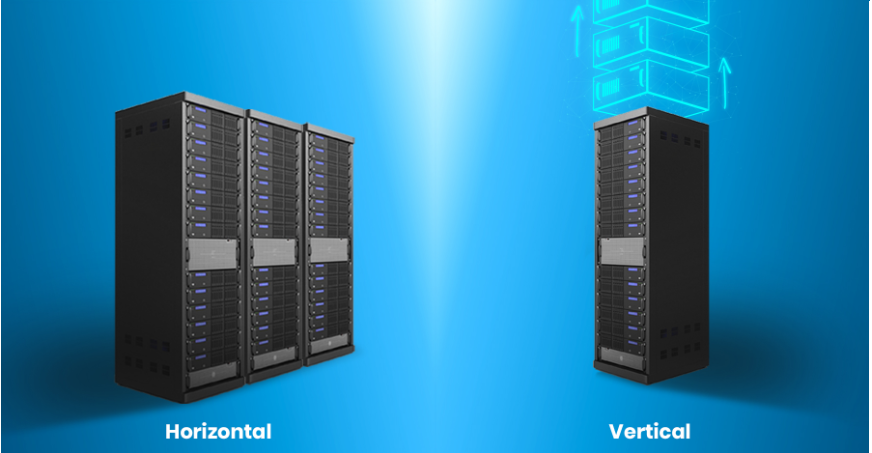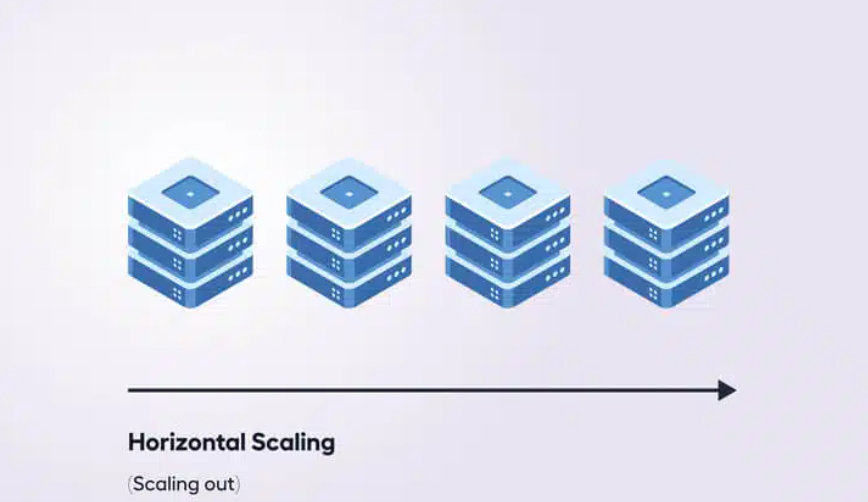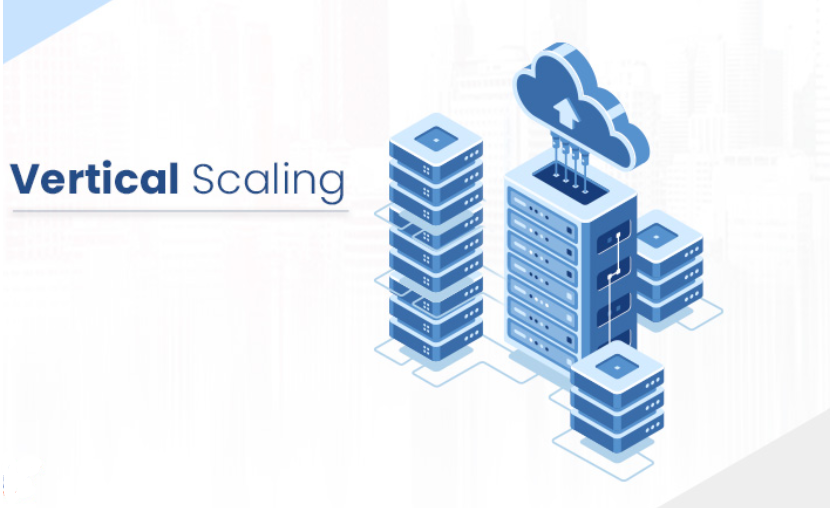Vertical and Horizontal scaling
 jiban swain
jiban swainTable of contents

What is Scaling❓
Scaling, in the context of computing and IT infrastructure, refers to the process of adjusting the capacity or resources of a system to accommodate changes in workload, demand, or requirements. Scaling is essential for ensuring that applications, websites, and services can meet the needs of their users effectively and efficiently. There are two primary types of scaling: horizontal scaling (scaling out) and vertical scaling (scaling up).
There are 2 types of scaling❗
1- Horizontal Scaling
2- Vertical Scaling
**What is Horizontal Scaling (Scaling Out) :**❓
Horizontal scaling involves adding more machines or instances to your infrastructure to handle increased load or demand. In the context of hosting a blog or website, this means adding more servers to your server farm or cloud environment as your traffic and resource needs grow.

Horizontal scaling involves adding more identical instances or servers to distribute the load and handle increased demand.
This approach is often used to enhance redundancy, availability, and performance.
For example, in a web application, you might add more web servers to your server farm or more virtual machines to your cloud environment as user traffic increases.
Horizontal scaling typically requires load balancing to evenly distribute incoming requests across the available instances.
Advantages of Horizontal Scaling
Horizontal scaling comes with a host of benefits, such as:
Easily scalable tools.
Supporting linear amplifies the capacity.
Easier to run fault tolerance.
Easy to upgrade.
Better use of smaller systems.
The cost of implementing is less expensive compared to scaling up.
Improved resilience due to the presence of discrete, multiple systems.
Horizontal scaling can be used to implement Infinite Scale, where you can use endless instances to enable limitless growth.
Disadvantages of Horizontal Scaling
But before you jump onto the horizontal scaling bandwagon, you should know that it comes with several drawbacks, including:
The architectural design is highly complicated.
You might have to pay high licensing fees.
Horizontal scaling solutions can increase your utility costs, such as cooling and electricity.
Horizontal scaling results in a bigger footprint for your data center
You need to invest in extra networking equipment, such as routers and switches.
What is Vertical Scaling (Scaling Up): ❓
Vertical scaling involves increasing the capacity of a single server or virtual machine by adding more resources to it. In the context of hosting a blog or website, this means upgrading the hardware or adjusting the configuration of an existing server to handle increased traffic and resource demands.

Vertical scaling involves increasing the capacity of an individual server or virtual machine by adding more resources like CPU, RAM, storage, or network bandwidth.
It is often used to improve the performance or capacity of a single system.
For example, you might upgrade a server's CPU, add more RAM, or attach additional storage devices to handle higher resource demands.
Vertical scaling is limited by the hardware's maximum capacity and can become cost-prohibitive for very high resource requirements.
Advantages of Vertical Scaling
Here are a few benefits of vertical scaling:
Reduced software costs as the underlying hardware nodes often don’t increase.
Easy Implementation.
Lower licensing fees.
Vertical scaling solutions often consume less power.
Cooling costs are lower than horizontal scaling.
Application compatibility is maintained.
Disadvantages of Vertical Scaling
On the other hand, vertical scaling solutions can have the following drawbacks:
The limited scope of scaling.
The risk for downtime is much higher than horizontal scaling.
Greater risk of outages and hardware failures.
Finite scope of upgradeability in the future.
Severe vendor lock-in.
The cost of implementation is expensive.
Vertical Scaling vs Horizontal Scaling: Which Should You Choose, And When ❗
Both vertical and horizontal scaling have advantages and drawbacks. Hence, you must choose the option that best fits your needs and available resources because there is no one-size-fits-all approach for enterprises. We recommend the following factors that you should include in your decision-making process:
Cost 🪙
Horizontal scaling solutions could have higher up-front hardware purchase costs. Alternatively, vertical scaling is often a better fit for businesses with limited budgets, and the need to quickly and inexpensively add more capacity to your infrastructure.
Future-proofing
By horizontally scaling, you can extend the performance limits by adding better equipment.
Topographic Distribution
It is unrealistic to expect all your clients to access your services from a single computer in a single place, especially if you have an international clientele. Therefore, you must scale your resources horizontally to maintain your service level agreement in this scenario.
Reliability
Horizontal scaling might provide you with a more dependable system. It ensures that you are independent of a single machine and have redundancy built into your processes. For example, when one machine malfunctions or doesn’t work, another one might be able to take over temporarily.
Cost: The Final Determinant (In Most Cases)
Regardless of your goals or the requirements of your organization, pricing may ultimately influence your choice. Although functionally speaking, horizontal scaling seems excellent; you might need help to afford it (right now). However, it’s still vital to remember that you can have additional options outside of on-premise vertical and horizontal scalability.
You can combine the two or move your company’s infrastructure to a cloud service provider, which will take care of scaling on your behalf. In the long run, the latter may be more practical and financially feasible for you.
RedSwitches has a great team of engineers who can advise you in choosing the right scalability approach and how you can move your infrastructure to managed bare-metal servers. We help you migrate your software resources so that you can enjoy faster and more future-proof bare-metal solutions for your business operations.
Conclusion
To summarize, businesses need to identify what suits their business requirements and understand the differences between these two scaling approaches, i.e., vertical and horizontal scaling, to see if their application goals fit the chosen model.
To accomplish superior performance, you can use vertical scaling, horizontal scaling, or both in a cloud environment. Many auto-scalable models are comparatively better than traditional scaling models and are well known for their performance without downtime.
Subscribe to my newsletter
Read articles from jiban swain directly inside your inbox. Subscribe to the newsletter, and don't miss out.
Written by

jiban swain
jiban swain
👋 Hello! I'm Jiban Kumer about DevOps and have over 1.5+ years of experience in the field. I'm proficient in a variety of cutting-edge technologies and always motivated to expand my knowledge and skills. Let's connect and grow together! SKILLS: 🔹 Languages & Runtimes: Python, Shell Scripting, HCL, YAML 🔹 Cloud Technologies: AWS, GCP 🔹 Infrastructure Tools: Docker, Terraform, AWS CloudFormation 🔹 Other Tools: Linux, Git and GitHub Actions, Jenkins, Jira, GitLab (beginner), Docker, AWS DevOps